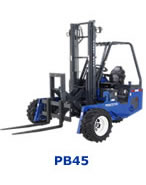
07 Oct Forklift Safety and Equipment: Chain Inspection/Maintenance
The forklifts most warehouses put to work are responsible for a variety of different tasks each and every day. And the eventual wear and tear that occurs to those machines can be discovered early and fixed; small problems can develop into much bigger problems quickly—each inspection should be performed with care and accuracy. Two areas on the machine, both of which are absolutely integral to its everyday capabilities, are the forks and the chain. When the forks/chain have damage or excessive wear it could lead to an eventual total breakdown. The problem with this type of breakdown is that it could be responsible for an employee injury or even death.
Everyday inspections are vitally important to your machines overall health. When you check the forks, check the surfaces for any cracks or dents; check for signs of excessive wear; check the welds where the forks are attached to the lift truck. If you notice any damage in these areas then it is probably time to have those damages repaired, or, in some cases, to replace any damaged components.
Check that the blade and the shank are in good shape; blades and shanks should not have any bends—if a blade or shank is bent, even slightly, the damage should be fixed before the forklift is used again in service. The angle of the blade and shank is also vitally important to forklift safety. If the blade and shank exceed 93 degrees, the entire fork must be replaced before the machine is used in service. There are also a number of other possible damages (all of which are listed as inspection protocols in the OSHA checklist).
Chains undergo a tremendous amount of wear and tear from daily use. And other environmental conditions within the warehouse—dirt, rust, dust, and water (or any combination)—also affect its performance/longevity. Rust and corroded chains should be replaced, immediately. Look for cracks in the chain, damage to the track, and misalignment. Look for wear and tear that could develop into a potential problem.
And remember, when a forklift’s components are damaged or worn out beyond the point of safe use, it’s time to replace/repair those components. If you have any other forklift questions, then call Anderson Forklift today.




No Comments